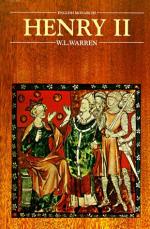The triumph of the Angevin conqueror was now complete. The baronage lay crushed at his feet. The Church was silent. The royal authority had been pushed, at least in name, to the utmost limits of the island. The close of this first work of settlement was marked by a royal progress between September 1157 and January 1158 through the whole length of England from Malmesbury to Carlisle. It was the king’s first visit to the northern shires which he had restored to the English crown; he visited and fortified the most important border castles, and then through the bitter winter months he journeyed to Yorkshire, the fastnesses of the Peak, Nottingham, and the midland and southern counties. The progress ended at Worcester on Easter Day, 1158. There the king and queen for the last time wore their crowns in solemn state before the people. A strange ceremony followed. In Worcester Cathedral stood the shrine of St. Wulfstan, the last of the English bishops, the saint who had preserved the glory of the old English Church in the days of the Confessor, and carried it on through the troubled time of the Conquest, to whose supernatural resources the Conqueror himself had been forced to yield, and who had since by ever-ready miracle defended his city of Worcester from danger. On this shrine the king and Queen now laid their crowns, with a solemn vow never again to wear them. To the people of the West such an act may perhaps have seemed a token that Henry came among them as heir of the English line of kings, and as defender of the English Church and people.




